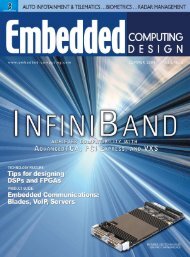CompactPCI and AdvancedTCA Systems - OpenSystems Media
CompactPCI and AdvancedTCA Systems - OpenSystems Media
CompactPCI and AdvancedTCA Systems - OpenSystems Media
You also want an ePaper? Increase the reach of your titles
YUMPU automatically turns print PDFs into web optimized ePapers that Google loves.
EDITOR’S FOREWORD<br />
EDITOR’S FOREWORD<br />
age modules, <strong>and</strong> PICMG AMC.4 specifies<br />
how to use Serial RapidIO for module<br />
interconnects. These are all nearly complete<br />
or under member review.<br />
SHB Express (PICMG 1.3)<br />
Known as System Host Board for PCI<br />
Express, this specification updates the<br />
old, but still popular PCI-ISA Passive<br />
Backplane Specification. SHB Express<br />
incorporates PCI Express serial fabric<br />
interconnects as well as cable-less connections<br />
to important I/O, including Ethernet<br />
<strong>and</strong> disk drives. Employing parallel PCI<br />
remains as an option, so designers can use<br />
older I/O cards if desired. And, yes, the<br />
venerable ISA bus is gone – for good.<br />
<strong>AdvancedTCA</strong> RapidIO (PICMG 3.5)<br />
The work on this subsidiary spec is<br />
largely completed, <strong>and</strong> the spec is out for<br />
member review. PICMG 3.5 adds Serial<br />
RapidIO to the list of fabric technologies<br />
defined for <strong>AdvancedTCA</strong>.<br />
<strong>AdvancedTCA</strong>300<br />
(Appendix to PICMG 3.0)<br />
This variant of <strong>AdvancedTCA</strong> details<br />
the building of systems that comply with<br />
popular 300 mm telecom equipment practices.<br />
The Rear Transition Module (RTM)<br />
is eliminated <strong>and</strong> the front board is shortened.<br />
This is mainly a modification to the<br />
mechanics of <strong>AdvancedTCA</strong> only, so it is<br />
expected to become an Appendix to the<br />
main specification.<br />
MicroTCA (PICMG MTCA.0)<br />
The idea behind this spec is simple:<br />
plug AMCs directly into a backplane to<br />
create small, cost effective systems for<br />
applications that don’t need the processing<br />
power or cannot afford the higher<br />
basic cost of <strong>AdvancedTCA</strong>. MicroTCA<br />
systems can be as small as a h<strong>and</strong>ful of<br />
modules to larger, switched systems with<br />
redundant resources. There is a great<br />
amount of industry excitement around<br />
MicroTCA, <strong>and</strong> first prototypes were<br />
shown at SUPERCOMM in June. The<br />
development subcommittee is working<br />
to have a released specification in early<br />
2006. See both the December 2004 <strong>and</strong><br />
the May 2005 issues of <strong>CompactPCI</strong> <strong>and</strong><br />
<strong>AdvancedTCA</strong> <strong>Systems</strong> for more detail<br />
about MicroTCA.<br />
CompactTCA (PICMG 2.50)<br />
This group is working to define a set of<br />
best practices combining:<br />
■ Switched Ethernet fabric of<br />
PICMG 2.16<br />
■ Management of PICMG 2.9 <strong>and</strong> 3.0<br />
■ Telecom clocks consistent with<br />
PICMG 2.5<br />
■ AC/DC power supply<br />
implementation compliant with<br />
PICMG 2.11<br />
PICMG 2.50 also m<strong>and</strong>ates the use of<br />
a centralized Shelf Manager/Hot Swap<br />
Controller <strong>and</strong> defines an external management<br />
interface consistent with the<br />
Service Availability Forum’s Hardware<br />
Platform Interface (HPI) specification.<br />
Other activities<br />
In addition to its customary hardware,<br />
board, platform level, <strong>and</strong> software specifications,<br />
PICMG is broadening the scope<br />
of work it undertakes by collaborating with<br />
other industry st<strong>and</strong>ards organizations <strong>and</strong><br />
consortia to harmonize activities.<br />
One such liaison activity is the PICMG/<br />
VITA XMC effort, wherein the PICMG<br />
members have organized to provide VITA<br />
comments <strong>and</strong> recommendations for<br />
the VITA 42 st<strong>and</strong>ard, which defines a<br />
PCI Express fabric on PMC modules.<br />
A much more comprehensive activity is<br />
beginning as a result of PICMG’s charter<br />
member status in the Mountain View<br />
Alliance (MVA), a consortia of consortia<br />
whose goal is to harmonize popular<br />
industry hardware <strong>and</strong> software st<strong>and</strong>ards<br />
to ease system integration. For more on<br />
MVA, please see the Specification Corner<br />
column in this issue.<br />
Joe Pavlat<br />
Editorial Director<br />
RSC# 10 @www.compactpci-systems.com/rsc<br />
10 / <strong>CompactPCI</strong> <strong>and</strong> <strong>AdvancedTCA</strong> <strong>Systems</strong> / September 2005

















